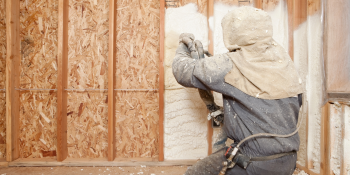Q&A Forums
Newbie question Post New Topic | Post Reply
| Author | Comments |
|---|---|
|
John Kish
Posted: Sep 05, 2008 05:27 PM
|
Newbie question
If I have my roof deck sprayed with 2 inches of CC foam and I have R30 blown fiberglass on the attic floor that isn't removed, what would be my resulting living space R value?R44? (R30 + (2 * R7/inch) Any reason not to do this? |
|
Jim Coler
Posted: Sep 05, 2008 06:15 PM
|
It really depends on a lot of other factors. The fact is you can't take fiberglass' stated R-values at face value. Training from Energy Star through BPI states that existing fiberglass should be rated and it is never rated at it's face value. Typically, fiberglass insulation is between 30-50% of it's stated R-value because of how it's installed, air passage through it, compression, damage to it from install or rodents, gaps and voids in install, or just colder temperatures. So, your R-30 is probably only about an R-10-15. The second issue is the thickness of closed cell. Is it thick enough to prevent condensation in your climate? The other issue you might experience is a warmer attic because it's trapped air between two layers of insulation which will hold the heat and may make it warmer in the summer time in the house. You'r blocking some of the Solar heat gain with the 2" closed cell, but it's not enough to prevent the heat from entering the attic and getting trapped. You might want to consider 6" of open cell which might be a comparable price. Then if someone messes with your fiberglass insulation by installing can lights or other air penetrations into the attic space, it doesn't matter because you have enough insulation thickness on the roof underside. |
|
John Kish
Posted: Sep 05, 2008 07:46 PM
|
I'm aware of the derating of fiberglass, but have always wondered how that played with code requirments. For example, if I currently have R30 blown FG and I were to completely replace with 6 inches of OC foam, is that a code violation even though the fiberglass is really only R 10-15? I'm in the Atlanta area - is 2 inches enough to prevent condensation? We get temps between roughly 0F and 100F. If not, what is the right amount? I have 3 goals in mind when looking at foaming my attic. I want to improve my home's envelope, keep critters out of the attic, and reduce dust and pollen. Sealing with foam seems like a good way to accomplish this. I also have an air handler/furnace with associated duct work in the attic so I'll improve HVAC performance as well. Anything I'm missing? |
|
William Gibson
Posted: Sep 10, 2008 06:56 AM
|
My guess is that your blown fiberglass is dense packed in a floor? or is it Loose-Fill overtop of the floor? If it were me I'd install another 3" (max) if not 2.5" of CC to what is already there and call it done. Who cares if you pocket warm air up there or not. R30 Fiberglass will slow the warm air down from getting to the attic, but it won't get past the attic because of the CC. |
|
John Kish
Posted: Sep 10, 2008 10:23 AM
|
It is loose-fill (fluffy) on top of the attic floor. There are also some vertical surfaces that have fiberglass batts. I guess it depends on how warm the pocket is as to whether anybody cares or not, but being a newbie, I don't really know. I've gotten conflicting information (that's what makes this hard) as to whether it matters. I've heard advice from one extreme to another. |
|
Jim Coler
Posted: Sep 10, 2008 12:24 PM
|
One concern popped up with your reply. You mentioned a furnace in the attic. If it's an open combustion furnace (90% eff or less) then you need to drywall around the furnace and seal this off as a utility room - This is typically not easy or practical so the other option would be to replace the furnace with a higher efficiency furnace which is sealed combustion. You can propbably get away with the 2" CC or 4" of OC, but I would recommend 3-4"CC or 6"OC so you don't have to worry if someone compromises the other insulation layer on the floor. |
|
William Gibson
Posted: Sep 10, 2008 01:57 PM
|
If it were me I'd go with this approach... Since your heating unit is in the attic, bring that attic "indoors". Only way to do that is insulate the underside of the roof (slopes?). I'd do that with another 2.5"-3" of Closed Cell Foam. I like the 4.5" Closed Cell Foam property of no heat transfer until -30 degrees Fahrenheit. If you seperate the heating unit from the house (in other words bring it outside your thermal barrier) then your unit will be working twice as hard to produce hot air for your home. Another questions I guess I'd ask is if the unit and the ducts are insulated? |
|
John Kish
Posted: Sep 10, 2008 02:16 PM
|
Yes, the furnace is an 80% gas non-sealed combustion unit with insulated ducts and of course, I've had conflicting advice on whether it needs to have fresh air delivered or not. More than one person has argued that since the rest of the house won't be tightly foam sealed that the furnace would still be getting enough air and our protection would be a CO2 detector at the furnace just in case. Others say that without a doubt fresh air is required. Again, how do I to determine what is right? I would prefer to not have to change the furnace right now as my plan was to go heat pump in the future, but was awaiting some on the horizon technology improvements to arrive (inverter base compressors). |
|
William Gibson
Posted: Sep 10, 2008 03:45 PM
|
To determine whether fresh air is needed or not the only way to realistically tell is by calling any contractor who completes Home Energy Audits. Make sure the audit consists of a blower-door test as well as CO analyzer. While they are testing to find out if fresh air is or isn't needed most also check all appliances in the home as well as effectiveness of insulation and windows. |
|
John Kish
Posted: Sep 10, 2008 04:50 PM
|
I assume that you would have the blower door test done after foaming the roof since that would change things quite a bit. |
|
Posted: Sep 10, 2008 05:56 PM
|
Newbie, I've read the responses to your question and there's several good points to consider. First, I would suggest you decide on closed cell or open cell at the necessary thickness for your home (never mind the fiberglass). To consider it as an essential part of the solution would be to believe the R-Value is as advertised. Let it be the extra. We would suggest open cell at 6 inches covering the rafters and sealed to the top plate. All vertical exterior walls in the attic could be sprayed with about 3 1/2 inches (your codes are to be considered) covering the studs as you go. The furnace located in the attic presents another problem that can be solved with the help of a HVAC professional providing venting (usually to the soffit) so that any combustion air required comes from the outside. In the event that you're snowed in for days on end in the Atlanta area, you won't have to worry about oxygen depletion. I know, but it's just a safety precaution. New high efficient systems will work in a closed attic assembly but not necessarily as well as they should, and the older units will often not work at all. If you want to put a band-aid on it, short change the foam, if you to fix it, use the appropriate amount of foam. Open cell for this application is going to cost less. Neither foam will keep out all animals, but the odor reduction from inside of the home will help and either will help with dust, allergens, and sound. Remember that penetrations from bath rooms and hot water heaters must also be considered and should pass through the attic. If the hotwater heater is in the attic, combustion air should come from the outside. Hope this helps, good luck. |
|
Gerry Wagoner
Posted: Sep 10, 2008 07:27 PM
|
I'd say 6" OC or 3.5" of Closed cell. For this application I prefer open cell due to the extra thickness and its ability to cover the rafter faces. Go gettum, |
|
William Gibson
Posted: Sep 10, 2008 10:02 PM
|
Kish: To respond to your question... Yes, your best bet is to get the necessary work completed then get the audit completed. I am sure it is hard for you to get a straight answer as every contractor out there has their own preference. My idea would be to one, go with a nationally recognized company that has standards you must follow. In New York there is BPI Accreditation. This is a training and testing procedure that contractors can take to further their credibility. It is a goverment funded and nationally recognized company. The second option would be to call on your local insulation contractors and go with your gut feeling of who treats you the best. Make sure they show up on time, are straight forward, good appearance and have credibility. Don't be afraid to see if they have certifications in their field. Also a big help is local references. If they run a good operation they will keep a list of references as well as have some photos of prior work. Just some ideas. But for what its worth (one final time) I'd put 2.5" of CC over what CC is already there and call it complete. In my eyes anything over 4.5" CC is overkill, not needed. Then get an audit to see if ventilation is needed for the combustion appliance. OC is great for the cost, but it doesn't match up to CC in heat resistance. Spend an extra dollar on CC in the beginning and save down the road. I represent a company that does both, and to be honest we can turn a better dollar on our Open Cell. However, we go with what we prefer FOR the customer, not for our wallet. If the CC price is out of budget we press for the OC obviously. As I am sure all the other contractors are like us, we want to give the best job possible to the customer. We know we can do that with CC Foam. |
|
Gerry Wagoner
Posted: Sep 11, 2008 07:42 AM
|
We seem to be assuming that our friend has 2" of closed cell there already. In his opening post however, he indicates that he is THINKING about getting 2" of closed cell foam. That was only 5-days ago. Keep the trigger pulled, oG |
|
John Kish
Posted: Sep 11, 2008 09:36 AM
|
Yes, just to clarify, I have no foam currently installed in my home. In the attic, there is R30 blown fiberglass. Prior to posting here, I had received the following suggestions: 1) Install 3" OC foam, leave fiberglass 2) Install 5" OC foam, leave fiberglass 3) Install 2" CC foam, maybe leave fiberglass Thanks to the helpful responses here, it seems that it should be narrowed down to installing 3-4.5" CC foam or 5-6" OC foam and remove fiberglass. After that is done, test attic to determine fresh air requirements for furnace. Anything missing or wrong there? |





























